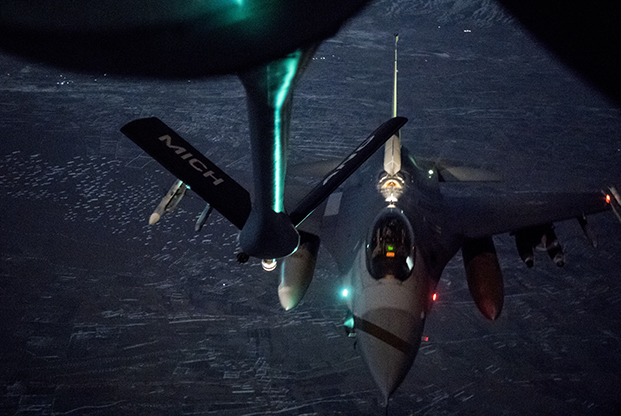
A USAF KC-135 Stratotanker assigned to the 340th Expeditionary Air Refueling Squadron refuels an F-16 Fighting Falcon over Afghanistan, on Jan. 22, 2019. Air Force photo by SSgt. Clayton Cupit.
The Air Force is struggling to define its roles both as a warfighter and as an enabler for the other services to fight. This “identity crisis” is affecting the service’s competition for resources within the Defense Department, the RAND Corp. writes in an extensive new report on military culture.
RAND, on Monday, released a 267-page report, sponsored by the Defense Department’s Office of Net Assessment, entitled “Movement and Maneuver: Culture and the Competition for Influence Among the US Military Services.” The report, written by six authors and sourced heavily by anonymous interviews with uniformed and civilian service officials, states the Air Force’s main goal is to make “air superiority a central tenet of American strategy.” This ensures that Pentagon leadership and Congress view the Air Force as more than just an enabler of other services, and acknowledges that USAF aircraft and airmen do more than conduct support operations for ground and sea forces.
“It behooves the Air Force to be viewed by Congress and OSD as a premier warfighting entity in its own right in order to help win resourcing battles,” the report states. “It is also important for the Air Force to be viewed as an equal service by the services that have had a more direct role in fighting on the ground since 2002, as it serves as a way of demonstrating and validating the Air Force’s contributions.”
Complicating this effort is the lack of blue suiters in joint operational leadership positions, an issue USAF Chief of Staff Gen. David Goldfein has publicly tried to address by emphasizing joint leadership as one of his top three focus areas.
In addition, the report states that broad USAF leadership is dominated by fighter pilots, which drives the service’s overall focus on resources and takes the focus away from other specialties, such as space and cyber.
“The dominance of [a] fighter culture drives resource decisions, leadership positions, and the impression that outside entities have of the Air Force,” according to the report. “The predominance of fighter pilots in high-level leadership roles creates a hierarchy within the service that places fighter pilots first, bombers second, and other specializations after.”
According to RAND, there has been little desire to shift away from culture, especially among those who “serve in the Air Force’s prized specialization.” For example, a former USAF general officer told RAND that “Unless your Chief gets fired, the likelihood of space or cyber becoming Chief are low. They might not even want to. Not everyone can aspire to be the Air Force Chief of Staff.”
Overall, there seems to be an inferiority among USAF leadership that “drives the Air Force to continually reinforce its multiple, unique, and complex mission areas when competing for resources with the other services,” the report states. The Air Force has been able to win budget battles, however, driving some resentment from other services.
“Others see the Air Force as valuing technology above all else, experiencing an internal identity crisis, and as being highly effective in competing for resources,” the report states.